GardenerHeaven.com is reader-supported. When you buy through links on our site, we may earn an affiliate commission.
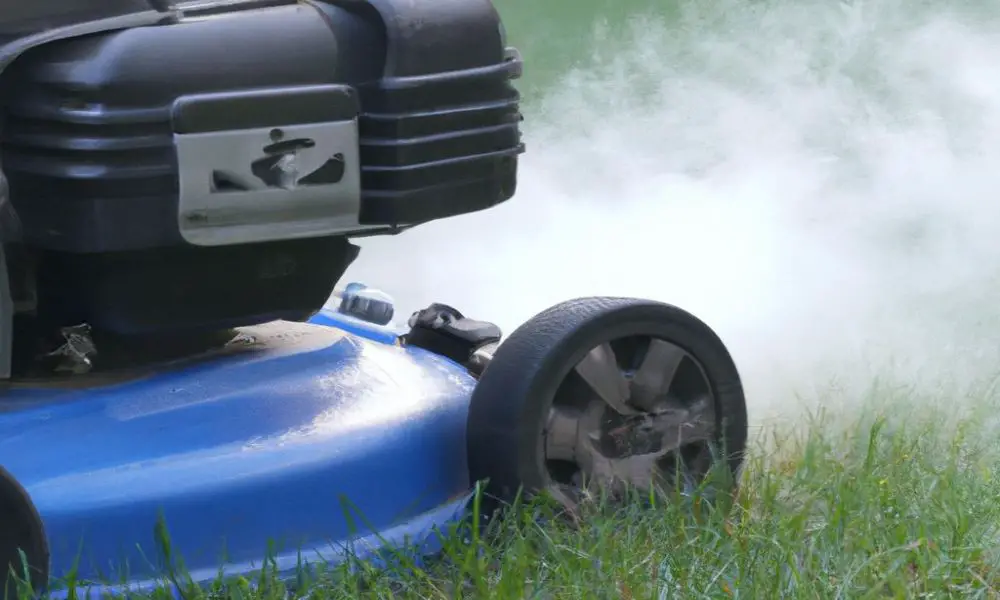
Lawn mower backfire when starting can be a frustrating issue, but understanding the causes can help you find the right solutions. In this article, we’ll delve into the world of lawn mower backfire, exploring what it is, why it happens when starting, and most importantly, how to fix it. By the end, you’ll be equipped with the knowledge to tackle this common problem head-on and get your lawn mower running smoothly.
Understanding Lawn Mower Backfire
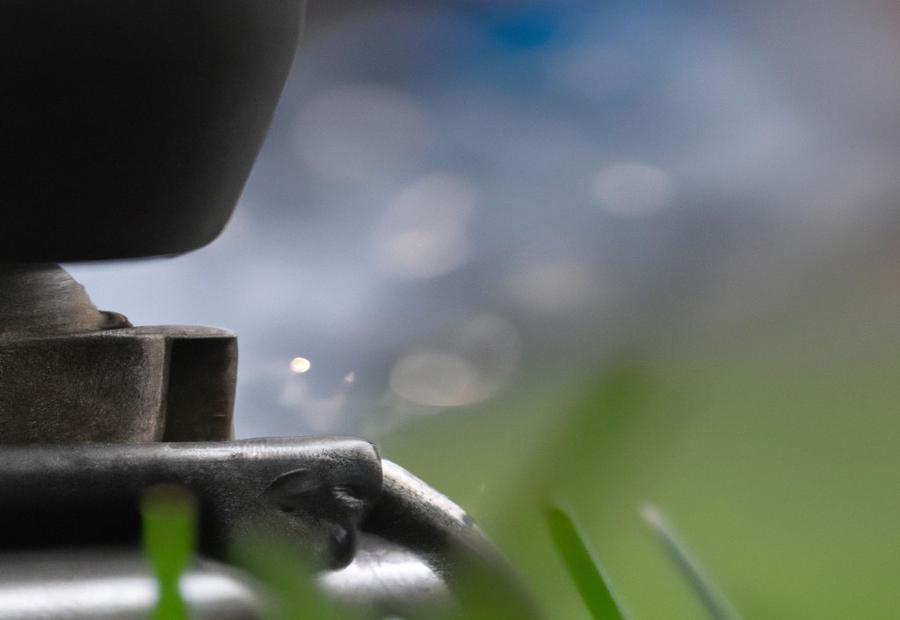
Photo Credits: Gardenerheaven.Com by Harold Allen
Backfire is a common problem with lawn mowers, especially when starting. You know it when you hear a loud popping sound or see a flame come out of the exhaust system. To understand why it happens and what to do about it, you need to know the various factors that cause it and the solutions to fix it.
The main cause is usually a faulty spark plug. It causes incomplete combustion, leading to backfiring. Air leaks in the fuel system can also be to blame. When there are cracks or loose connections, too much air can get in, disrupting the fuel-air mixture and resulting in backfiring.
Carburetor settings can also cause backfiring. If they’re not adjusted properly, it can create an overly rich or lean fuel mixture, which leads to backfire. Low-quality fuel or gasoline with high ethanol content can also cause it.
Engine timing issues can also lead to backfire when starting. If it’s off, it can disrupt the combustion sequence and cause misfires and backfiring. You may need to check and adjust the timing.
To fix backfire when starting, there are several solutions:
- Check and replace the spark plug.
- Repair any air leaks in the fuel system.
- Adjust the carburetor settings.
- Use high-quality fuel and ethanol-free gasoline.
- Check and adjust the engine timing if needed.
To prevent backfire when starting in the future, do regular maintenance and inspections. Plus, follow proper storage and fuel handling practices and take precautions when starting the lawn mower, like following the manufacturer’s guidelines and using proper starting techniques.
To keep your lawn mower running efficiently, you need to understand the causes and solutions for backfire when starting. Take action and implement preventive measures to ensure a smoother and safer starting experience. Otherwise, your grass will fight back with a bang!
What is Lawn Mower Backfire?
Why does the Lawn Mower backfire when starting? It’s caused by the combustion of fuel and air in the engine at the wrong time. Faulty spark plugs, air leaks in the fuel system, improper carburetor adjustment, and engine timing issues are all common causes.
To fix it, check the spark plug, repair any air leaks, adjust the carburetor, use high-quality fuel, and adjust timing. Preventive maintenance and proper storage also help. Plus, following the manufacturer’s instructions when starting can help avoid backfiring.
But why does the Lawn Mower backfire when starting? Because it’s just not a real party until the grass fights back!
Why Does Lawn Mower Backfire When Starting?
Do you ever wonder why your lawn mower backfires during startup? This can be caused by several things that affect the engine’s ignition and fuel system. Here are some possible reasons:
- The spark plug may not be giving the right spark if it’s worn out or damaged.
- Air leaks in the fuel system can disrupt the fuel-air mix and cause backfiring.
- Improper carburetor adjustment can throw off the fuel mixture and lead to backfire.
- Low-quality or contaminated fuel, as well as high ethanol content, can also cause backfire.
- Engine timing issues can impact synchronization and lead to unexpected backfires.
It is important to do regular maintenance and inspection on the lawn mower. Also, use proper fuel handling and storage practices, and take safety precautions while starting the mower. This way, you can keep your lawn mower running properly and have a safe start.
Common Reasons for Lawn Mower Backfire When Starting
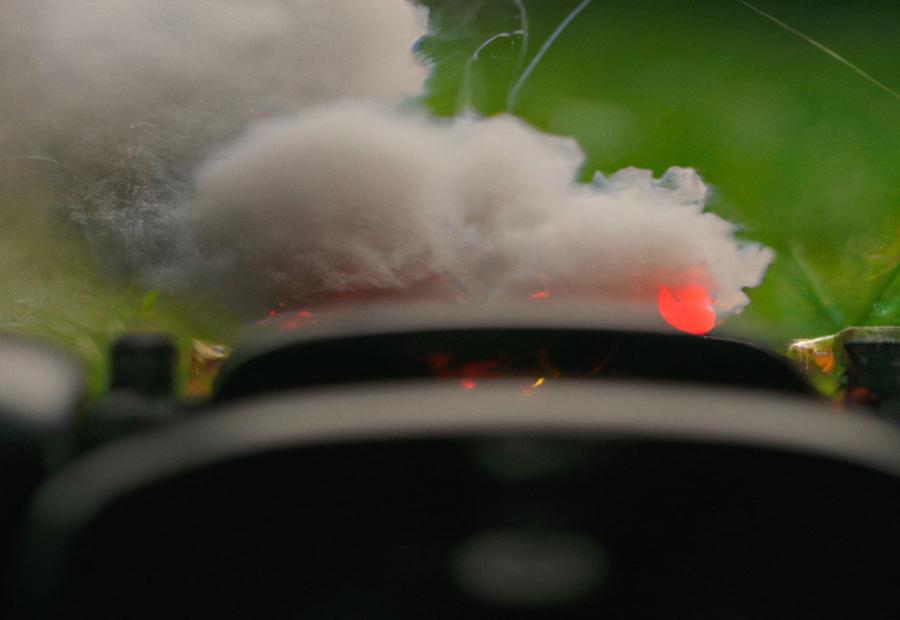
Photo Credits: Gardenerheaven.Com by Gary King
When it comes to the frustrating phenomenon of lawn mower backfiring during starting, there are several common reasons to consider. From a faulty spark plug to air leaks in the fuel system, improper carburetor adjustment to fuel quality and ethanol content, and even engine timing issues, understanding these potential causes is essential for resolving the problem. So, let’s uncover the culprits behind lawn mower backfire and explore the solutions to get your mower running smoothly.
Faulty Spark Plug
A faulty spark plug can cause a lawn mower to backfire when starting. It is responsible for igniting the fuel-air mixture in the engine’s combustion chamber. If it’s faulty, it may not create a strong enough spark. This leads to incomplete combustion and backfiring.
Reasons for a faulty spark plug include worn or damaged electrodes, excessive carbon buildup, and incorrect gap spacing between the electrodes. A faulty spark plug can be identified by examining its condition and doing a spark test. If one is detected, it should be replaced immediately. This prevents further backfiring and ensures a smooth starting.
It is vital to understand that the spark plug is key to the ignition process. It produces an electrical spark, which ignites the fuel-air mixture. But, if it’s faulty, it may not make a consistent and strong enough spark, resulting in unburned fuel expelled from the exhaust system and backfiring.
Issues associated with a faulty spark plug can contribute to backfiring when starting. Worn or damaged electrodes, carbon buildup, and incorrect gap spacing can all hinder proper sparking. Therefore, regularly inspecting and maintaining the spark plugs is essential to identify any potential problems and ensure smooth starting.
Air Leaks in the Fuel System
Air leaks in the fuel system can cause lawn mowers to backfire when starting. Cracks or openings in the system allow air to enter where it shouldn’t. This disrupts the fuel system and causes an air-fuel imbalance.
Parts like fuel lines, gaskets, and seals can be prone to air leakage. Worn-out or damaged components can also contribute to these openings.
Air entering the fuel system affects the fuel-to-air ratio, resulting in a lean mixture. This lean mixture can cause insufficient combustion and create conditions for backfire when starting.
These air leaks may not be visible. But they can cause symptoms like rough running, stalling, or backfiring. It is essential to address them quickly to avoid damage.
Careful inspection is needed to identify and fix air leaks. Regular maintenance helps detect these issues early. This way, you can reduce the chances of the lawn mower backfiring when starting and ensure smooth operation.
Improper Carburetor Adjustment
Backfire when starting a lawn mower? It’s often caused by an improper carburetor adjustment. This happens when the air and fuel mix isn’t balanced. Too rich or too lean? Excess backfiring.
Solve it:
- Find the adjustment screws on the carburetor. Usually two – one for high-speed, one for low-speed.
- Set the screws per manual instructions. Gently turn clockwise until they stop.
- Start the mower. Let it warm up. Adjust the high-speed screw clockwise for a smooth, steady engine. Low-speed screw for optimal performance without hesitation or backfiring.
Note: Other factors can affect carburetor settings. Consult your manual or seek help if needed.
By adjusting the carburetor, backfire issues will be minimized and you’ll get smooth mower operation. Etha-no, thank you for backfiring!
Fuel Quality and Ethanol Content
Fuel quality and ethanol content can affect lawn mower backfire during starting. Poor fuel or too much ethanol can disrupt the engine’s combustion process. This could lead to a loud popping sound or even flames coming out of the exhaust!
Let’s look at the table:
| Column 1: Fuel Quality | Column 2: Ethanol Content |
|---|---|
| High-quality, low impurities | Low or no ethanol (preferably ethanol-free) |
| Clean, refined gasoline | Ethanol blends within the manufacturer’s recommended limits |
Using poor-quality fuel or too much ethanol can cause engine issues, including backfires. So, it’s important to use clean, refined fuel with low impurities for optimal performance.
Other factors that could contribute to backfire include faulty spark plugs, air leaks in the fuel system, carburetor adjustment, and engine timing issues. Address these potential causes to reduce backfire and make starting smoother.
Engine Timing Issues
Improper sync of the engine’s combustion process can cause backfire during startup. This happens when the spark plug ignites the fuel mix at the wrong time, leading to an explosion in the intake or exhaust system, instead of within the combustion chamber. Engine timing issues, like a misaligned camshaft, worn-out timing chain, or a malfunctioning crankshaft position sensor, can affect the precise timing needed for efficient combustion.
One unique thing: engine timing issues can be caused by incorrect adjustments to the ignition timing. This is when inexperienced users or mechanics without proper knowledge alter it. It can lead to disruption of the engine and result in a backfire during startup.
To prevent this, do regular maintenance and inspection of all components involved in correct engine timing. This will detect and fix any issues with misaligned camshafts, worn-out timing chains, or malfunctioning sensors. Also, seek professional help for adjustments to ignition timings. This will prevent avoidable problems before they occur.
Solutions for Lawn Mower Backfire When Starting
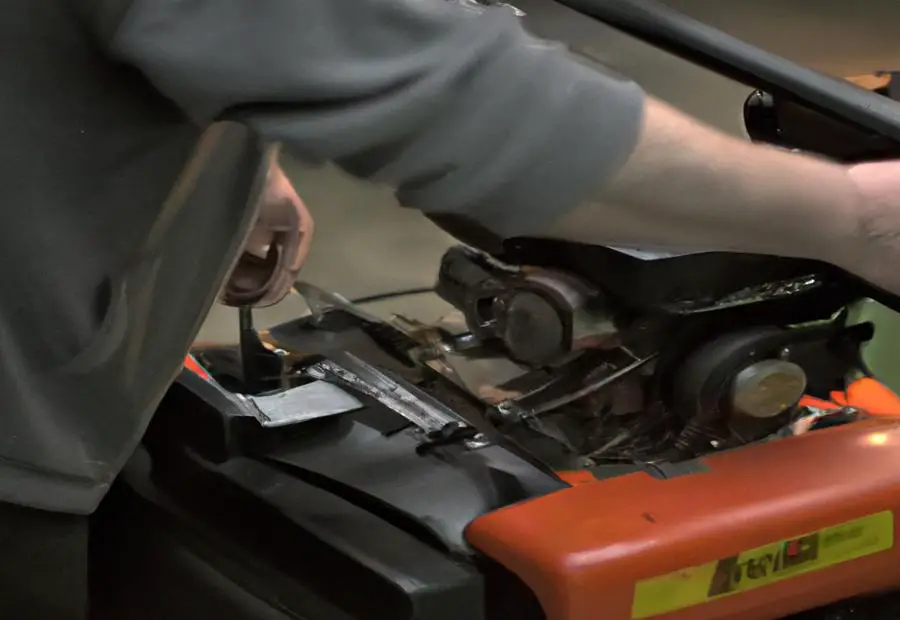
Photo Credits: Gardenerheaven.Com by Larry Perez
If your lawn mower is backfiring when starting, fear not! We have the solutions you need to fix the problem. From checking and replacing the spark plug to repairing air leaks in the fuel system, adjusting carburetor settings, using high-quality fuel, and checking engine timing, we’ll cover all the steps you can take to eliminate that pesky backfire. Say goodbye to the frustration and get your lawn mower running smoothly again.
Checking and Replacing the Spark Plug
The spark plug has a major part in a lawn mower’s ignition system. It helps create the spark to light the fuel mix, so the engine starts and runs smoothly. Regularly reviewing and replacing the spark plug is key for the lawn mower’s proper function and to avoid backfire happening when starting.
To check and change the spark plug, here are 3 steps:
- Visual Examination:
- Unplug the spark plug wire from the spark plug.
- Look for damage or wear like cracked insulator, worn electrode or too much carbon buildup.
- If you see damage or wear, it’s best to replace the spark plug.
- Gap Measurement:
- Use a feeler gauge to measure the gap between the center electrode and ground electrode of the spark plug.
- Refer to the lawn mower’s manual or maker’s recommendations for the right gap measurement.
- If the gap is too wide or narrow, carefully adjust it using an appropriate tool without damaging either electrode.
- Replacement:
- If the visual inspection doesn’t show any damage but you suspect a fault, it’s best to replace it.
- Make sure to use a compatible replacement spark plug suitable for your lawn mower model.
- Fit the new spark plug by hand-tightening it in place. Be careful not to overtighten it as it can cause damage.
It’s essential to do regular upkeep and inspection of all components to get optimal performance and to stop backfire when starting your lawn mower.
- Plus, there are some special aspects to remember when inspecting and replacing the spark plug.
- Disconnect the spark plug wire before doing any examination or replacement to avoid accidental ignition.
- Consider using a torque wrench when tightening a new spark plug for precise torquing.
- Lastly, using a spark plug gap tool can give more precise and consistent gap measurements.
In the past, lawn mower engines had non-removable or shielded spark plugs, making them hard to access for inspection and replacement. But, with design and technology improvements, modern lawn mowers now have easily accessible spark plugs that can be reviewed and replaced with less trouble. This advancement has made regular maintenance tasks like checking and replacing the spark plug more convenient for lawn mower owners.
Repairing Air Leaks in the Fuel System
To repair fuel system air leaks, follow these 5 steps:
- Inspect Fuel Lines and Connections – Check for cracks or damage. Make sure all connections are secure.
- Replace Damaged Fuel Lines – If needed, replace with compatible lines.
- Tighten Loose Connections – Use tools to tighten any loose connections to prevent air entering.
- Inspect Gaskets and Seals – Look for worn-out or damaged gaskets and replace them.
- Use Sealant or Tape – For small leaks, use sealant or tape designed for gasoline applications.
Remember to check other components such as the primer bulb and carburetor diaphragm as they can also cause air leaks. Take immediate action to avoid further engine damage. According to an article, addressing fuel system air leaks will prevent backfires. (source: Unknown).
Adjusting the Carburetor Settings
The carburetor in a lawn mower is so important. It mixes fuel and air for combustion. Adjustment of the carburetor is needed for better engine performance. To do this, follow these 4 steps:
- Find the carburetor. It’s usually near the engine and has screws on it.
- Identify the screws. Usually two – one for the fuel mix (high-speed screw) and one for the idle speed (low-speed screw). They have unique shapes or labels.
- Adjust the fuel mix. Turn the high-speed screw clockwise until it’s snug. Then turn counterclockwise 1 to 1.5 turns. This is the baseline for other adjustments.
- Fine-tune idle speed. Start the mower, and wait a few minutes. Then, turn the low-speed screw clockwise to increase idle, or counterclockwise to decrease. Achieve smooth, consistent operation.
Wrong adjustments can cause engine damage. Get help if unsure. Maintenance and inspection also help. Clean the carburetor components and check all connections. Advances in technology improved design and precision. Older models need manual adjustment. Newer mowers have user-friendly mechanisms. The goal is the same – optimal fuel and air mixture. Use high-quality fuel and ethanol-free gasoline. Give your mower a spa treatment!
Using High-Quality Fuel and Ethanol-free Gasoline
High-quality fuel is key for proper combustion in the engine, thus lowering the odds of backfiring during start-up. Ethanol-free gasoline helps avoid issues like moisture absorption and separation from the fuel mix. It also stops clogging and damage to the fuel system components. Ethanol-free gasoline further shields the carburetor from corrosion and deposits, which can interfere with its proper functioning. To boost the stability and performance of the lawn mower’s engine, it’s important to avoid higher ethanol content fuels. Selecting a renowned brand of fuel that guarantees minimal ethanol content will guarantee better results.
It is essential to note that using high-quality fuel and ethanol-free gasoline is critical for the lawn mower’s engine to run smoothly and efficiently. It boosts combustion and reduces backfiring when starting. Timing is paramount – especially for the lawn mower’s engine!
Checking and Adjusting Engine Timing
To troubleshoot your lawn mower’s backfire, check and adjust the engine timing. This will prevent misfires and backfires for smoother operation. Follow these six steps:
- Unplug the spark plug wire.
- Locate the engine’s timing marks. Consult the manual.
- Set the piston to the top dead center (TDC).
- Check the ignition timing with a light.
- Adjust the ignition timing if needed.
- Test again.
By doing this, you can prevent backfires and optimize your lawn mower’s performance.
Preventive Measures to Avoid Lawn Mower Backfire When Starting
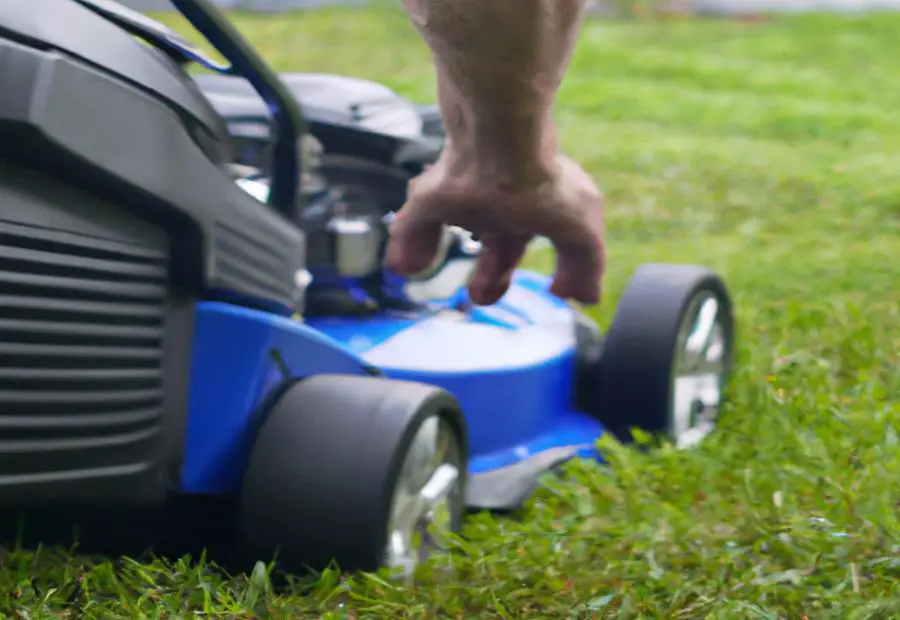
Photo Credits: Gardenerheaven.Com by Gregory Roberts
To prevent lawn mowers backfire when starting, it’s crucial to implement preventive measures. By adhering to regular maintenance and inspection, practicing proper storage and fuel handling, as well as taking precautions while starting the lawn mower, you can effectively mitigate the risk of backfire. With these preventive steps in place, you can ensure a smoother and more reliable operation of your lawn mower, avoiding any potential backfire-related inconveniences.
Regular Maintenance and Inspection
Regular maintenance and inspection are key for a long-lasting, functioning lawn mower. Doing so can stop any issues that cause backfiring when starting. Three easy steps to ensure regular upkeep:
- Cleaning: Clear away dirt, debris, and clippings off the outside of your mower to keep airflow going and prevent clogging in the engine.
- Lubrication: Put lubricant on the wheels, blades, and engine parts to reduce friction and wear.
- Component Check: Check the spark plug, air filter, fuel filter, and belts for damage. Replace any worn out parts for optimal performance.
In addition, store your lawn mower in a dry and secure place and keep fuel safe with manufacturer safety guidelines. Doing this, plus regular maintenance and inspection, significantly lowers the risk of backfiring when starting your lawn mower.
Remember: Store your fuel properly or risk turning your lawn mower into a ticking time bomb!
Proper Storage and Fuel Handling
Store fuel in a cool and dry place, it is important! Use approved containers made of sturdy material and with a tight-fitting lid. Handle fuel with care; use a funnel when filling up your mower’s tank. Avoid smoking or open flames near the fueling area. Inspect stored fuel for signs of contamination or degradation. Dispose of old or spoiled fuel, it may cause engine issues if used. Following these procedures can ensure your fuel remains clean and free from contaminants, reducing the risk of backfiring and other issues.
Taking Precautions while Starting the Lawn Mower
Precautions are key for protecting yourself and your lawn mower. Follow these 4 steps for safety and to avoid any potential accidents:
- Scan the area for anything the mower might hit, like rocks, debris, or toys. Get rid of potential hazards.
- Wear the right protective gear – safety goggles, ear protection, shoes, and long pants. Keep yourself safe from flying debris and sound.
- Place the mower on a level surface with the cutting blade turned off. This prevents unintentional movement or the blade from coming on.
- Firmly hold the handlebars and stand behind the machine, away from the discharge chute. Start the engine according to the manufacturer’s instructions, and keep your feet away from the rotating parts.
It’s important to be mindful of these precautions. Regular maintenance, proper storage and fuel handling, and correct usage are needed for safe operation. Following these steps can help you maintain your lawn without any backfire issues at startup.
Conclusion

Photo Credits: Gardenerheaven.Com by Steven Adams
Backfiring when starting a lawn mower is a common problem. It can be caused by a clogged carburetor, moisture in the fuel, or a faulty ignition system. To avoid this, it is important to:
- Clean and maintain the carburetor regularly.
- Use fresh fuel.
- Ensure that the ignition system is working correctly.
Following these steps will help you dodge the frustration and damage that comes with backfiring. Plus, your lawn mower will start up smoothly and efficiently.
Carburetors can become clogged with debris and impurities, affecting fuel flow and combustion. So, regular maintenance and cleaning is key to preventing backfiring.
Moisture in the fuel can also cause backfiring. When water or condensation enters the fuel system, it can disrupt the fuel-to-air ratio – resulting in incomplete combustion. To prevent this, use fresh fuel and store it in a clean, dry container. You can also use a fuel stabilizer to reduce the effects of moisture.
A faulty ignition system can also lead to backfiring. If the spark plug is worn or the ignition coil is not working, it can affect the timing of combustion and cause backfiring. To prevent this, inspect and replace the spark plug regularly and make sure the ignition system is functioning.
A homeowner’s story highlights the importance of maintaining a lawn mower to prevent backfiring. They were having frequent backfires when starting their mower, so they decided to invest time in cleaning the carburetor, replacing the spark plug, and using fresh fuel. As a result, the backfiring issues were resolved and they enjoyed hassle-free mowing.
To sum up, proper maintenance is critical for preventing backfiring in lawn mowers. Cleaning and maintaining the carburetor, using fresh fuel, and making sure the ignition system is working correctly are essential to avoid backfiring and ensure a smooth start for your lawn mower. Taking these measures will help you enjoy a stress-free mowing experience and prolong the life of your equipment.
Some Facts About “What Causes Lawn Mower Backfire When Starting? Common Reasons and Solutions”:
- ✅ Backfires in a lawn mower can occur when starting, running, or shutting off the engine. (Source: LawnMowerGuru)
- ✅ Common causes of backfiring include decelerating the engine too quickly, using improper gasoline, having a faulty spark plug or carburetor, and sheared flywheel keys. (Source: Team Research)
- ✅ A damaged flywheel or sheared flywheel key can cause backfiring when starting a lawn mower. (Source: Leading Gear)
- ✅ Incorrect carburetor settings, fuel quality, and muffler construction can lead to backfiring after shut down. (Source: Team Research)
- ✅ Regular maintenance, adjusting carburetor settings, using pure gasoline, and gradually reducing engine speed can help prevent backfiring. (Source: LawnEQ)
FAQs about What Causes Lawn Mower Backfire When Starting? Common Reasons And Solutions
What causes a lawn mower to backfire when starting?
Backfiring when starting a lawn mower can be caused by several factors, including a damaged flywheel, sheared flywheel key, or poor ignition. It can also be due to a lean carburetor, vacuum leak, or weaker spark. Water contamination in the fuel or exhaust system can also lead to occasional backfires.
How do I check if the flywheel or flywheel key is damaged?
To check if the flywheel or flywheel key is damaged, you need to partially disassemble the lawn mower by removing the blower housing and flywheel nut. If the flywheel key is not aligned with the keyway hole on the crankshaft, it is most likely sheared and needs to be replaced. A wire brush can be used to clean the flywheel and inspect it for any visible damage.
What can cause backfiring when shutting off a lawn mower?
Backfiring when shutting off a lawn mower can be caused by slowing down the speed too fast or engine overheating. Abruptly halting the engine after running at full speed can result in excess fuel in the combustion chamber, leading to a backfire. Engine overheating can cause poor combustion, which may also result in backfiring.
How can I prevent backfires when starting and shutting off my lawn mower?
To prevent backfires when starting and shutting off a lawn mower, it is recommended to gradually bring down the engine speed and let it idle for at least 30 seconds before turning it off. This allows the excess fuel to burn off and prevents backfiring. Additionally, using good quality gasoline without alcohol blends and ensuring proper carburetor adjustments can help prevent backfires.
What should I do if my lawn mower backfires?
If your lawn mower backfires, it is important to take appropriate action. Start by checking the spark plugs, and fuel mixture, and inspecting the exhaust for carbon buildup or any restrictions. Clean or replace the spark plugs if necessary. If the backfiring persists, it is recommended to seek professional help to diagnose and resolve the issue.
Can backfiring damage my lawn mower engine?
Although backfiring itself doesn’t directly damage the engine, it can indicate underlying issues that might lead to engine damage if not addressed. It is crucial to identify and resolve the cause of backfiring to ensure the proper functioning and longevity of your lawn mower engine.




